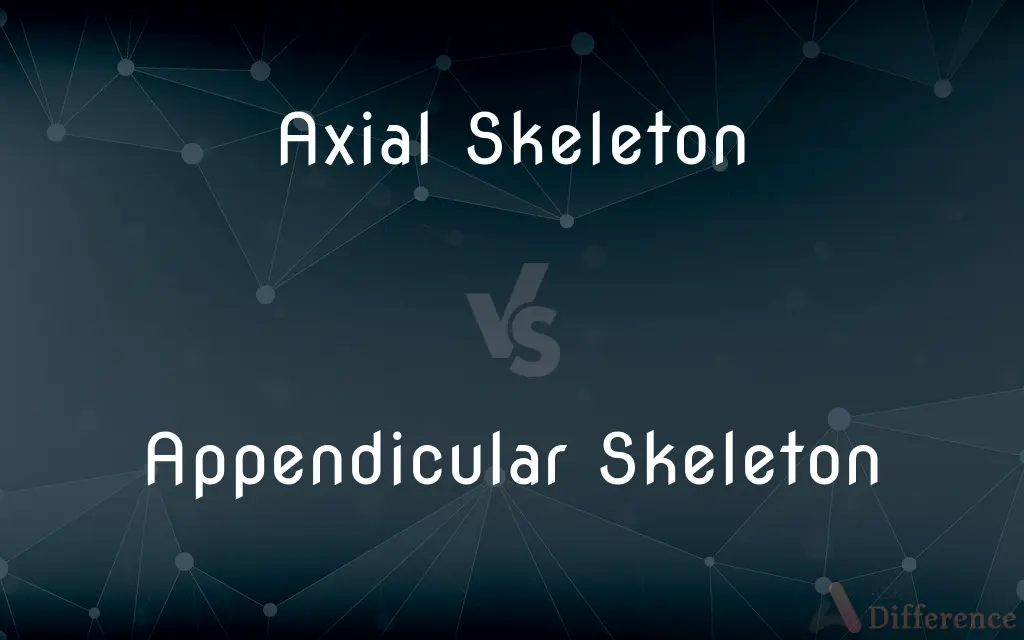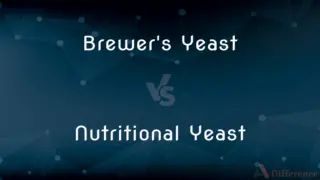Axial Skeleton vs. Appendicular Skeleton — What's the Difference?
Edited by Tayyaba Rehman — By Fiza Rafique — Published on December 2, 2023
The Axial Skeleton comprises the central core bones (skull, vertebrae, and rib cage), while the Appendicular Skeleton consists of limb bones and the pelvic girdle. Both are essential components of the human skeletal system.

Difference Between Axial Skeleton and Appendicular Skeleton
Table of Contents
ADVERTISEMENT
Key Differences
The Axial Skeleton and Appendicular Skeleton are two primary divisions of the human skeleton. The Axial Skeleton provides the main axis for the body, consisting of the skull, vertebral column, and rib cage. In contrast, the Appendicular Skeleton pertains to the limbs and the girdles connecting them to the axial portion.
When discussing the Axial Skeleton, it's important to note its protective function. For instance, the skull shields the brain, while the rib cage safeguards vital organs. The Appendicular Skeleton, on the other hand, is vital for movement. The bones of the arms, legs, and their associated structures provide the necessary mobility and flexibility.
In total, the Axial Skeleton is made up of 80 bones, including the skull bones, ossicles of the middle ear, hyoid bone, vertebral column, and the thoracic cage. On the contrary, the Appendicular Skeleton, more expansive in bone count, consists of 126 bones, comprising the limbs, and the pectoral and pelvic girdles.
Both the Axial Skeleton and the Appendicular Skeleton have undergone evolutionary changes throughout history. The Axial Skeleton's design provides upright posture in humans, while the evolution of the Appendicular Skeleton reflects the shift from quadrupedal to bipedal movement.
While both the Axial and Appendicular Skeletons serve different primary functions, they're interconnected and work in unison. The joints where the axial and appendicular bones meet, like the shoulder and pelvic joints, illustrate this crucial relationship.
ADVERTISEMENT
Comparison Chart
Primary Components
Skull, Vertebrae, Rib cage.
Limbs, Pectoral and Pelvic girdles.
Function
Protection of major organs, Support.
Movement, Attachment of limbs.
Bone Count
80 bones.
126 bones.
Evolutionary Significance
Supports upright posture.
Transition from quadrupedal to bipedal movement
Location
Central core of the body.
Attached to the body's periphery.
Compare with Definitions
Axial Skeleton
Bones forming the main axis, including the skull and spine.
The Axial Skeleton provides the framework for the body's core.
Appendicular Skeleton
The peripheral bone structures aiding in motion.
Athletes often focus on strengthening their Appendicular Skeleton.
Axial Skeleton
The foundational bone set supporting the head and trunk.
Studying the Axial Skeleton helps understand posture and support mechanisms.
Appendicular Skeleton
The mobile component of the skeletal system.
Understanding the Appendicular Skeleton is crucial in orthopedic medicine.
Axial Skeleton
The central structure of bones in the human body.
The Axial Skeleton supports and protects vital organs.
Appendicular Skeleton
Bones of the limbs and their attachments.
The Appendicular Skeleton facilitates movement and flexibility.
Axial Skeleton
The central bone framework, including the vertebral column.
Injuries to the Axial Skeleton can impact critical body functions.
Appendicular Skeleton
The skeletal parts connected to the body's axis.
Birds have specialized Appendicular Skeleton structures for flight.
Axial Skeleton
Core skeletal components excluding limbs and girdles.
The Axial Skeleton's design has evolved for protection and support.
Appendicular Skeleton
Bones comprising the arms, legs, and girdles.
The development of the Appendicular Skeleton reflects evolutionary shifts.
Common Curiosities
What bones are part of the Axial Skeleton?
The Axial Skeleton includes the skull, vertebrae, and rib cage.
What's the primary function of the Appendicular Skeleton?
The Appendicular Skeleton facilitates movement and supports limb attachments.
How many bones are in the Axial Skeleton?
The Axial Skeleton consists of 80 bones.
Why is the Appendicular Skeleton important for movement?
It comprises limb bones and girdles, essential for motion and flexibility.
How does the Axial Skeleton support posture?
It provides the central axis, supporting and aligning the body's main structures.
Which skeleton includes the pelvic girdle, Axial or Appendicular?
The pelvic girdle is part of the Appendicular Skeleton.
What evolutionary changes have affected the Appendicular Skeleton?
Its evolution reflects shifts from quadrupedal to bipedal movement in humans.
Do both the Axial and Appendicular Skeletons provide protection?
Primarily, the Axial Skeleton protects vital organs, while the Appendicular primarily aids movement.
Which skeleton has more bones, Axial or Appendicular?
The Appendicular Skeleton has more bones, with a total of 126.
Is the spinal column part of the Axial Skeleton?
Yes, the spinal column or vertebral column is part of the Axial Skeleton.
Are rib injuries considered Axial Skeleton injuries?
Yes, since ribs are part of the Axial Skeleton.
Where is the Appendicular Skeleton primarily located?
It's mainly on the body's periphery, including limbs and girdles.
Do all vertebrates have both Axial and Appendicular Skeletons?
Most vertebrates have some form of both, but the structures can vary significantly.
Are the shoulder blades part of the Appendicular Skeleton?
Yes, the shoulder blades (scapulae) are part of the Appendicular Skeleton.
Do the Axial and Appendicular Skeletons interact?
Yes, they're interconnected, especially at joints like the shoulders and pelvis.
Share Your Discovery

Previous Comparison
Brewer’s Yeast vs. Nutritional Yeast
Next Comparison
Microsoft NPS vs. Cisco ISEAuthor Spotlight
Written by
Fiza RafiqueFiza Rafique is a skilled content writer at AskDifference.com, where she meticulously refines and enhances written pieces. Drawing from her vast editorial expertise, Fiza ensures clarity, accuracy, and precision in every article. Passionate about language, she continually seeks to elevate the quality of content for readers worldwide.
Edited by
Tayyaba RehmanTayyaba Rehman is a distinguished writer, currently serving as a primary contributor to askdifference.com. As a researcher in semantics and etymology, Tayyaba's passion for the complexity of languages and their distinctions has found a perfect home on the platform. Tayyaba delves into the intricacies of language, distinguishing between commonly confused words and phrases, thereby providing clarity for readers worldwide.













































